
Janmajay Singh
Researcher
Researcher
Fujifilm Healthcare
Overview
I am a researcher working on developing novel statistical and computational models for challenging problems in medicine. With a formal background in computer science engineering followed by research in recommendation systems, my path to the health sciences has been rather unconventional. My interest in working in healthcare started in 2014, during my sophomore year, when I initiated a successful multi-departmental collaborative project to set up a digitization infrastructure for the university's hospital and allow patients and doctors easier access to medical records. Following this I wa selected to attend MIT for 2 semesters where I studied Machine Learning and researched at CSAIL with the late Prof. P.H. Winston as my advisor. Here, my work was to verify the feasibility of using the Genesis story understanding system for real-time clinical decision support by treating a patient-doctor conversation as a story.
Following graduation, I was 1 of 3 people selected from over 10 universities across India and China for a visiting scholarship at Fuji Xerox's Research headquarters after which I moved to Yokohama, Japan. At the conclusion of the scholarship, I was the first person without a doctorate to gain acceptance to the prestigious Communications Technology Laboratory in the research group where I mostly worked on recommendation systems. However, due to my interest in healthcare I initiated a new research theme on healthcare informatics within my department and convinced concerned stakeholders of the domain's scope and my ability by finishing 5th at an internationally renowned healthcare challenge.
Following a takeover in 2020, ~30 of 300 researchers were selected for a transfer to our new parent company's healthcare division, where I started working on liquid biopsy technology for early cancer diagnosis. My team consists of experienced researchers from varied backgrounds including biochemists, histopathologists, physicists, mathematicians and computer scientists in addition to collaborating doctors from the University of Tokyo. This has been an amazing learning experience and extensive cross-domain collaboration has also taught me how statistical methods like machine learning can play a significant role in making strides in computational biology research.
Mentorship
Recently, in my own time, I started a Research Mentorship program for undergraduate students from my alma mater. The goal of this program is to teach methods for carrying out principled research and provide guidance on necessary prerequisite coursework with occasional homework help. Three primary factors motivated me to initiate this program - general worry for current undergrads for missing out essential college experiences due to the COVID-19 pandemic, my own experience in collaborative, translational research and this paper which discusses how economic complexity can lead to sustained growth for a country. I strongly believe in cross-domain research and encourage my students to follow related career paths by providing frequent examples from my own experiences.This program has been selected for integration with my alma mater's Center for Excellence in 2022.
Research Interests
Since 2018, I have worked on various healthcare domains including informatics for intensive care units (with EMRs) cardiology (with ECGs) and cancer diagnosis (with omics). My interests categorized by application domain are:- Liquid Biopsy for early cancer diagnosis: Utilizing genomic patterns from multiple target biomarkers measured from a mixture of broken DNA fragments (cfDNA) while maintaining high specificity and sensitivity is an incredibly challenging problem. My work has been on two aspects of this task - reducing measurement noise by probabilistic modeling of systematic noise patterns during multiplex PCR targeted amplicon sequencing and developing novel methods of classification from cfDNA methylation patterns to improve upon the current state of the art. While working on the classifier I also started considering a simulator of methylation patterns when I came across a very interesting work on the information-theoretic nature of the epigenome. I strongly believe gaining a more complete model of the informational properties of the epigenome will not only lead to a better understanding of gene regulation but also to have a bottom-up understanding of genome-phenome relationships.
- Intensive Care EMRs: Long-term goal is to deploy machine learning models providing continuous risk assessment to attending physicians while also serving a decision support role (suggesting best interventions). Inherent sparsity of various variables makes such continous prediction difficult. My focus is on modeling temporal missingness (MNAR) patterns as artifacts of healthcare processes (rather than as effects of a patient's evolving health) and using these for intervention-aware prediction. In addition, taking inspiration from an example of computational advertising, I aim to use causal methods for modeling effects of feedback loops by a deployed clinical machine learning model.
- Data Augmentation for ECGs: Multiclass classification is hard and the Physionet 2020 challenge showed just how hard it can be especially for diseases with few samples. My interest lies in handling this problem without losing sight of biomedical interpretability by leveraging recent work on disentangling GAN representations. Finding highly correlated learned subspaces with linear combinations of more traditional ECG features may lead us to a "tunable" and interpretable data augmentation model.
For more details about my work, please see my Curriculum Vitae and Google Scholar.
2020-Present
Fujifilm Healthcare
Researcher, Computational Biology
Technical Report Award (2021)
2017-2020
Fuji Xerox Co., Ltd.
Researcher, Medical Informatics
Outstanding Research Award x2 (2020,2021)
2016-2017
Voonik Technologies
Research Intern, Recommendation Systems
2015-2016
Massachusetts Institute of Technology
Special Student, EECS
Research Mentor: P.H. Winston
2013-2017
SRM University
B.E., Computer Science and Engineering
First Class with Distinction
Selected Research
-
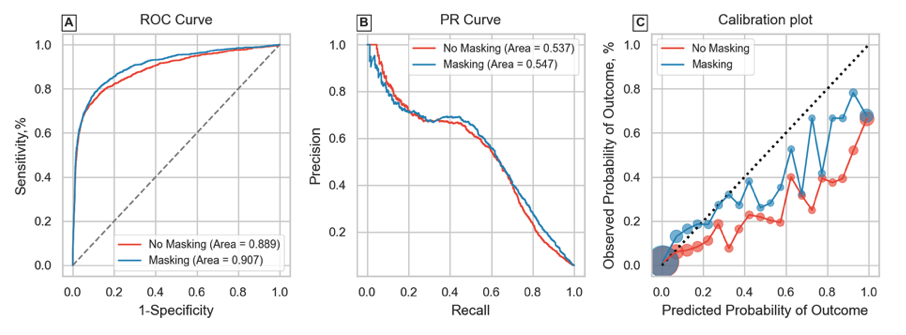
On Missingness Features in Machine Learning Models for Critical Care: Observational Study
Janmajay Singh, Masahiro Sato, Ohkuma Tomoko
JMIR Medical Informatics, 2021
[Abstract] [Paper]Background: Missing data in Electronic Health Records is inevitable and considered to be non-random. Several studies have found that features indicating missing patterns (missingness) encode useful information about a patient's health and advocate their inclusion in clinical prediction models. But their effectiveness has not been comprehensively evaluated. Objective: To study the effect of including informative missingness features in machine learning models for various clinically relevant outcomes and explore robustness of these features across patient subgroups and task settings.
Methods: A total of 48,336 electronic health records from the 2012 and 2019 Physionet Challenges were used and mortality, length-of-stay (LOS) and sepsis outcomes were chosen. The latter dataset was multi-center, allowing external validation. Gated Recurrent Units were used to learn sequential patterns in the data and classify or predict labels of interest. Models were evaluated on various criteria evaluating discriminative ability and calibration, as well as across population subgroups.
Results: Generally improved model performance in retrospective tasks was observed on including missingness features. Extent of improvement depended on the outcome of interest (AUROC improved 1.2% - 7.7%) and even patient subgroup. However, missingness features did not display utility in a simulated prospective setting, being outperformed (0.9% difference in AUROC) by the model relying only on pathological features. This was despite leading to earlier detection of disease (true positives), since including these features led to a concomitant rise in false positive detections.
Conclusions: This study comprehensively evaluated effectiveness of missingness features on machine learning models. A detailed understanding of how these features affect model performance may lead to their informed use in clinical settings especially for administrative tasks like LOS prediction where they present the greatest benefit. While missingness features, representative of healthcare processes, vary greatly due to intra and inter-hospital factors, they may still be used in prediction models for clinically relevant outcomes. However, their use in prospective models producing frequent predictions needs to be explored further. -
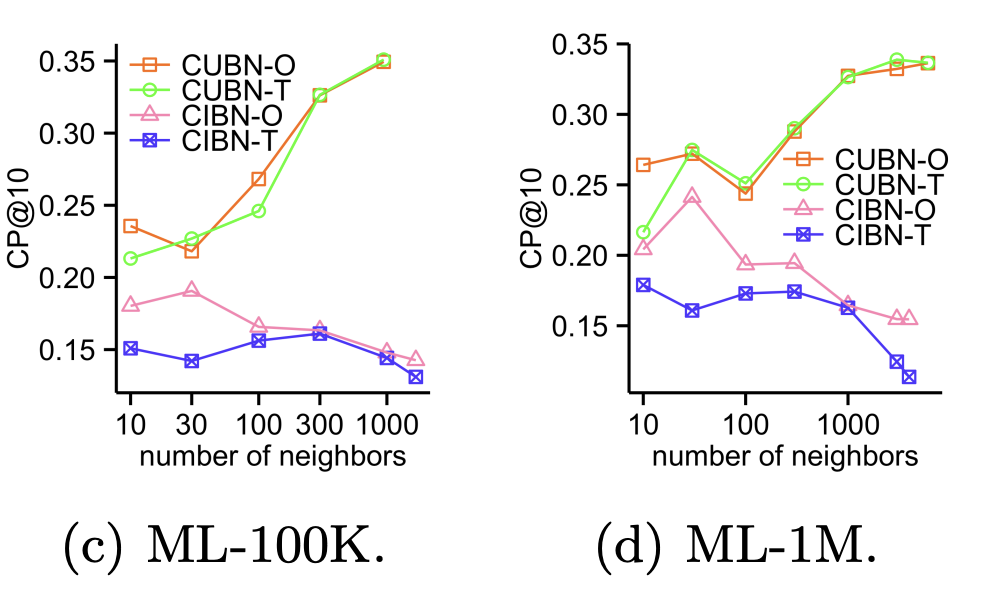
Causality-Aware Neighborhood Methods for Recommender Systems
Masahiro Sato, Janmajay Singh, Sho Takemori, Qian Zhang
ECIR '21: European Conference on Information Retrieval
[Abstract] [Paper]The business objectives of recommenders, such as increasing sales, are aligned with the causal effect of recommendations. Previous recommenders targeting for the causal effect employ the inverse propensity scoring (IPS) in causal inference. However, IPS is prone to suffer from high variance. The matching estimator is another representative method in causal inference field. It does not use propensity and hence free from the above variance problem. In this work, we unify traditional neighborhood recommendation methods with the matching estimator, and develop robust ranking methods for the causal effect of recommendations. Our experiments demonstrate that the proposed methods outperform various baselines in ranking metrics for the causal effect. The results suggest that the proposed methods can achieve more sales and user engagement than previous recommenders. -
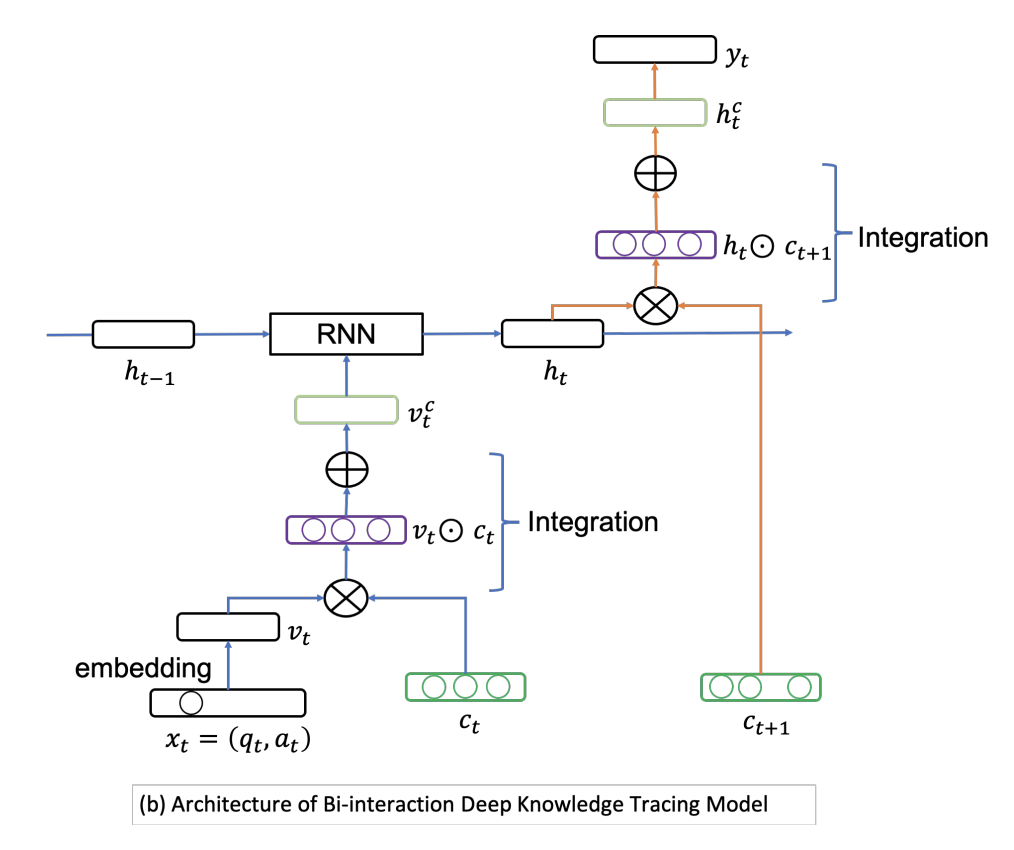
Incorporating Wide Context Information for Deep Knowledge Tracing using Attentional Bi-interaction
Raghava Krishnan, Janmajay Singh, Masahiro Sato, Qian Zhang, Tomoko Ohkuma
L2D’21: First International Workshop on Enabling Data-Driven Decisions from Learning on the Web
[Abstract] [Paper]Online learning platforms also known as Computer Aided Education Systems have recently grown in importance owing to their ability to personalize study plans in accordance with individual student requirements. Learning platforms have modeled student knowledge state using student responses with the recently popular Deep Knowledge Tracing (DKT) technique. Using context information has also proven effective in various predictive problems prompting learning platforms to store a variety of context features about a student’s performance history. An example context may be response time, where shorter times to answer questions may indicate higher mastery of a skill. Therefore, it is crucial to incorporate context features in the most effective way possible. Most of the research in DKT either use no context features, or use a set of context features that span only a narrow set of student characteristics. To overcome this, we identify a wide set of context features and incorporate their interactions into the DKT model. We then observe the effects of incorporating these additional context feature interactions and also propose an adaptive weighting technique that learns the appropriate context feature interaction weights. These techniques are compared with state-of-the-art baselines and their performances were evaluated using AUC scores. -
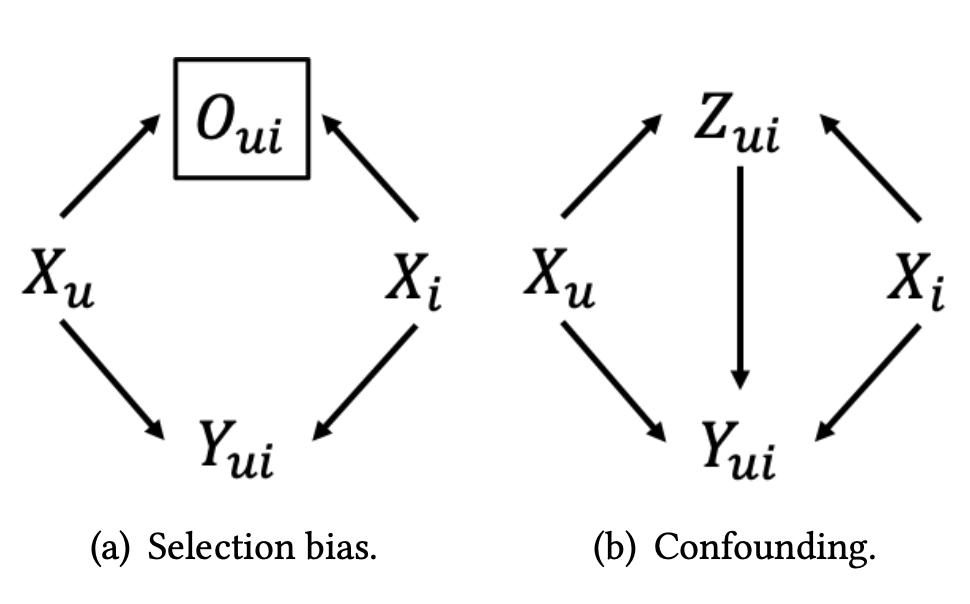
Unbiased Learning for the Causal Effect of Recommendation
Masahiro Sato, Sho Takemori, Janmajay Singh, Tomoko Ohkuma
RecSys '20: Fourteenth ACM Conference on Recommender Systems
[Abstract] [Paper]Increasing users’ positive interactions, such as purchases or clicks, is an important objective of recommender systems. Recommenders typically aim to select items that users will interact with. If the recommended items are purchased, an increase in sales is expected. However, the items could have been purchased even without recommendation. Thus, we want to recommend items that results in purchases caused by recommendation. This can be formulated as a ranking problem in terms of the causal effect. Despite its importance, this problem has not been well explored in the related research. It is challenging because the ground truth of causal effect is unobservable, and estimating the causal effect is prone to the bias arising from currently deployed recommenders. This paper proposes an unbiased learning framework for the causal effect of recommendation. Based on the inverse propensity scoring technique, the proposed framework first constructs unbiased estimators for ranking metrics. Then, it conducts empirical risk minimization on the estimators with propensity capping, which reduces variance under finite training samples. Based on the framework, we develop an unbiased learning method for the causal effect extension of a ranking metric. We theoretically analyze the unbiasedness of the proposed method and empirically demonstrate that the proposed method outperforms other biased learning methods in various settings. -
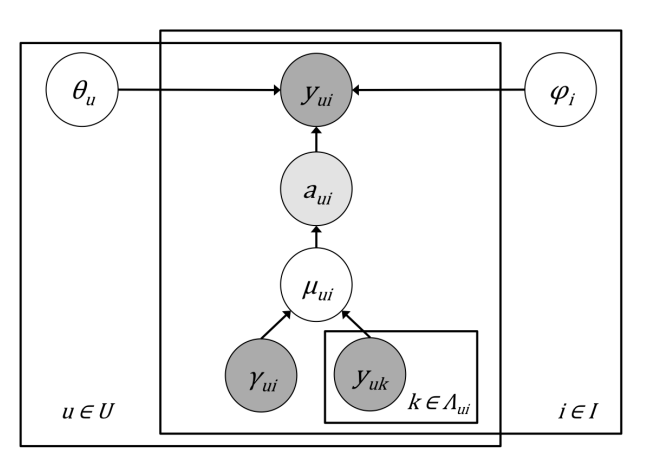
Modeling user exposure with recommendation influence
Masahiro Sato, Janmajay Singh, Sho Takemori, Takashi Sonoda, Qian Zhang, Tomoko Ohkuma
SAC '20: Proceedings of the 35th Annual ACM Symposium on Applied Computing
[Abstract] [Paper]Recommender systems learn users' preferences from their explicit feedback, such as ratings, and implicit feedback, such as purchases. Learning a user's preference from implicit feedback is difficult since inaction in such data can be because of either dislike for an item or unawareness. Exposure modeling has been proposed recently to address this ambiguity by decomposing inaction into dislike and unawareness. A user's awareness of items can be affected by several factors, and exposure modeling has been extended to include social and temporal influences on exposure to provide better recommendations. However, recommendation itself should also affect a user's awareness of items. Recommendations boost awareness differently for different users; while some users are attentive to and trust recommendations, others neglect or distrust recommendations. Furthermore, if a user purchases an item from a recommendation list, the user would have likely noticed other items on the same list. In this paper, we extend exposure modeling by considering the influence of recommendations on exposure. We accomplish this by incorporating: (1) user-dependent increase in awareness of recommended items and (2) indirect increase in awareness of an item by the purchase of other items from the same recommendation list. Through experiments using public datasets with recommendation logs, we demonstrate that considering recommendation influence improves purchase prediction. -
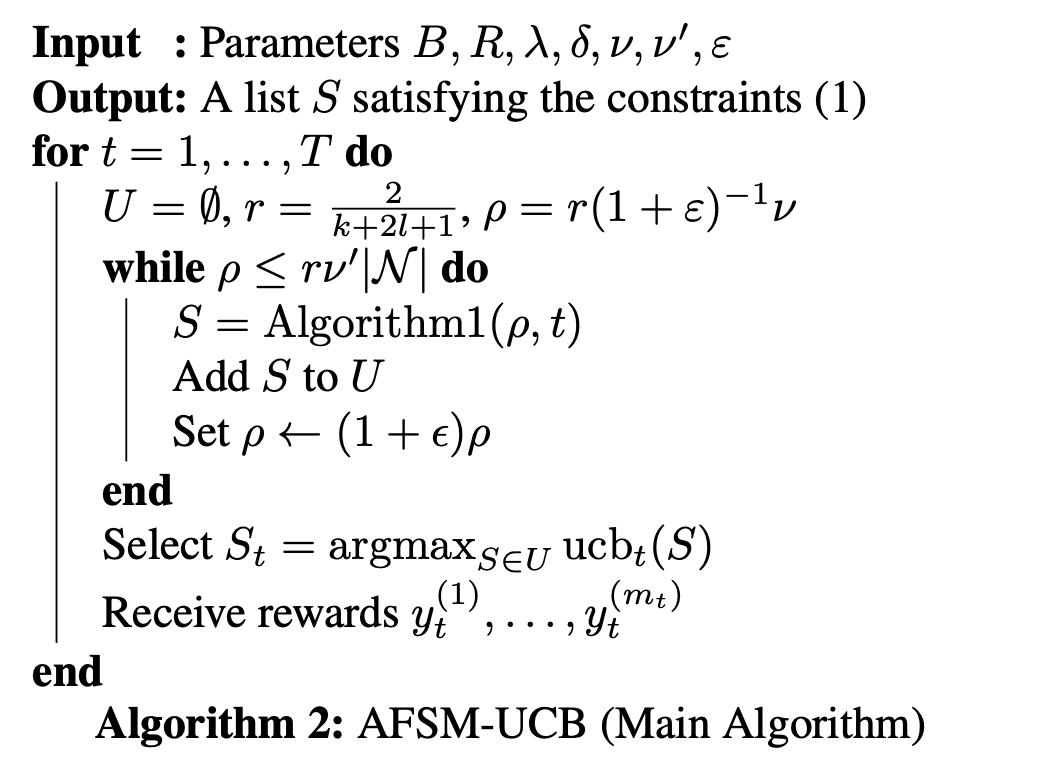
Submodular Bandit Problem Under Multiple Constraints
Sho Takemori, Masahiro Sato, Takashi Sonoda, Janmajay Singh, Tomoko Ohkuma
UAI '20: Proceedings of the 36th Conference on Uncertainty in Artificial Intelligence
[Abstract] [Paper]The linear submodular bandit problem was proposed to simultaneously address diversified retrieval and online learning in a recommender system. If there is no uncertainty, this problem is equivalent to a submodular maximization problem under a cardinality constraint. However, in some situations, recommendation lists should satisfy additional constraints such as budget constraints, other than a cardinality constraint. Thus, motivated by diversified retrieval considering budget constraints, we introduce a submodular bandit problem under the intersection of 𝑙 knapsacks and a 𝑘-system constraint. Here 𝑘-system constraints form a very general class of constraints including cardinality constraints and the intersection of 𝑘 matroid constraints. To solve this problem, we propose a non-greedy algorithm that adaptively focuses on a standard or modified upper-confidence bound. We provide a high-probability upper bound of an approximation regret, where the approximation ratio matches that of a fast offline algorithm. Moreover, we perform experiments under various combinations of constraints using asynthetic and two real-world datasets and demonstrate that our proposed method outperforms the existing baselines. -
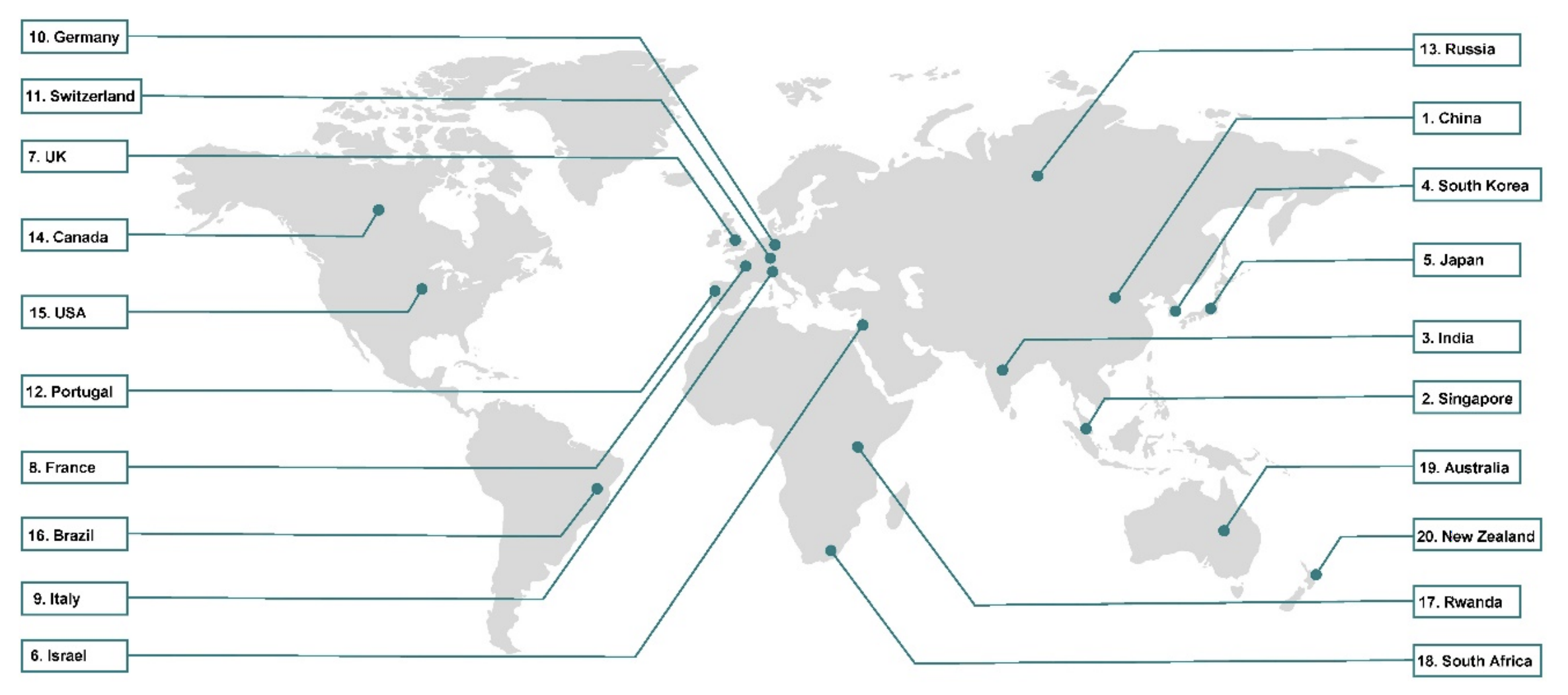
Remote health diagnosis and monitoring in the time of COVID-19
Joachim A Behar, Chengyu Liu, Kevin Kotzen, Kenta Tsutsui, Valentina D A Corino, Janmajay Singh, ..., Gari D Clifford
Physiological Measurement, 2020
[Abstract] [Paper]Coronavirus disease (COVID-19), caused by the severe acute respiratory syndrome coronavirus 2 (SARS-CoV-2), is rapidly spreading across the globe. The clinical spectrum of SARS-CoV-2 pneumonia requires early detection and monitoring, within a clinical environment for critical cases and remotely for mild cases, with a large spectrum of symptoms. The fear of contamination in clinical environments has led to a dramatic reduction in on-site referrals for routine care. There has also been a perceived need to continuously monitor non-severe COVID-19 patients, either from their quarantine site at home, or dedicated quarantine locations (e.g. hotels). In particular, facilitating contact tracing with proximity and location tracing apps was adopted in many countries very rapidly. Thus, the pandemic has driven incentives to innovate and enhance or create new routes for providing healthcare services at distance. In particular, this has created a dramatic impetus to find innovative ways to remotely and effectively monitor patient health status. In this paper, we present a review of remote health monitoring initiatives taken in 20 states during the time of the pandemic. We emphasize in the discussion particular aspects that are common ground for the reviewed states, in particular the future impact of the pandemic on remote health monitoring and consideration on data privacy. -
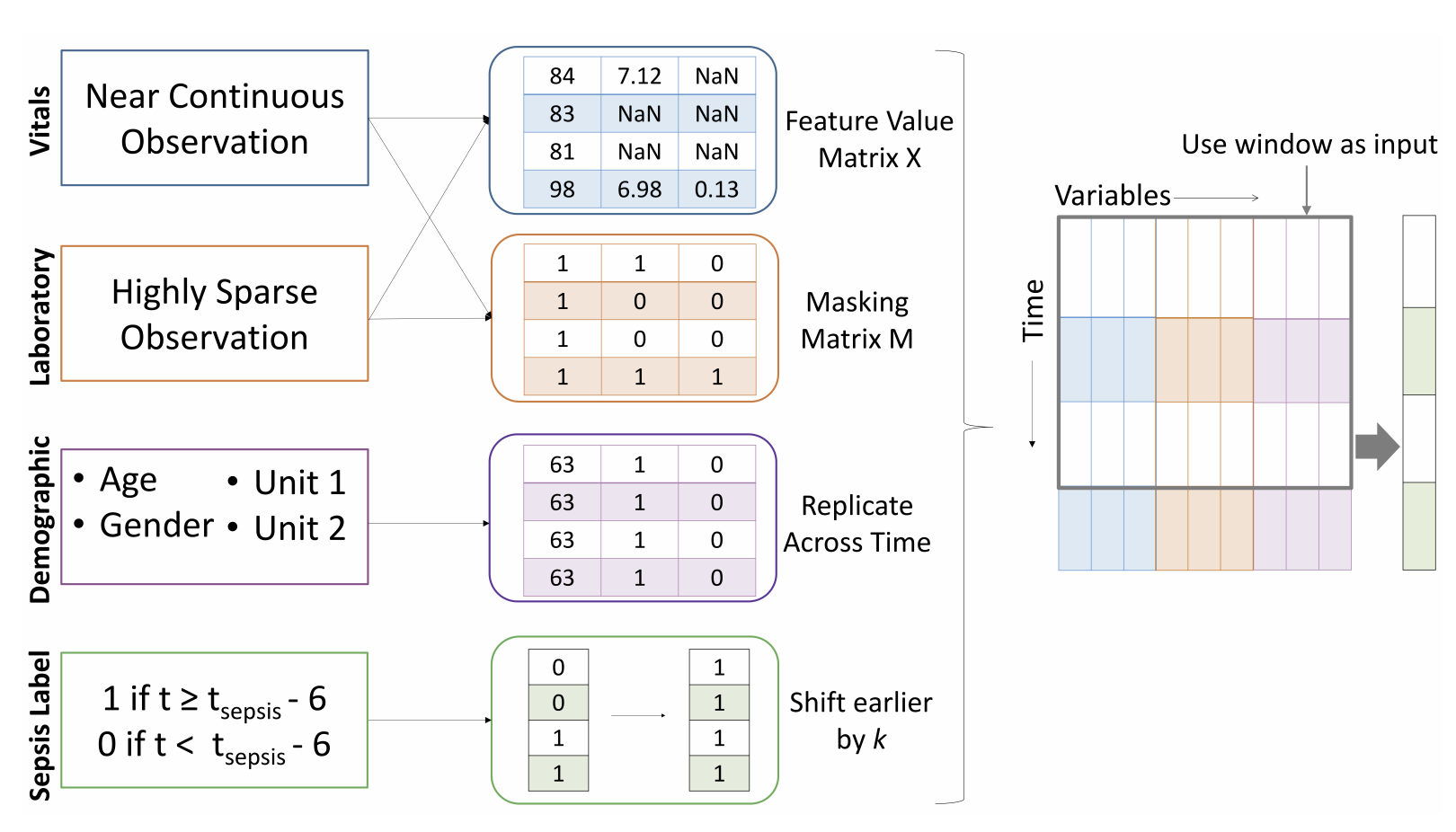
Utilizing Informative Missingness for Early Prediction of Sepsis
Janmajay Singh, Kentaro Oshiro, Raghava Krishnan, Masahiro Sato, Tomoko Ohkuma, Noriji Kato
Computing in Cardiology, 2019
[Abstract] [Paper]Aims: Physicians have to routinely make crucial decisions about patients’ health in the ICU. Sepsis affects about 35% of ICU patients, killing approximately 25% of the afflicted. In this paper, we aim to predict the occurrence of sepsis early by studying the missingness of physiological variables and using it with the overall trends in data.
Methods: We chose XGBoost as our base model and tried several variations by changing hyperparameters, window sizes and imputation methods. To further improve the model, we used masking vectors to represent the missingness of features in the dataset. Additional modifications include shifting the Sepsis Label to earlier time steps and tuning the classification probability threshold to further improve the model’s performance.
Results: The XGBoost model with a sliding window of size 5, no imputation, utilizing informative missingness of all temporal variables and trained on labels shifted by 3 hours before toptimal, achieved a Utility Score of 0.337 on the full test set. We identified as ”CTL-Team” in the challenge and were officially ranked 5th on the basis of this score. -
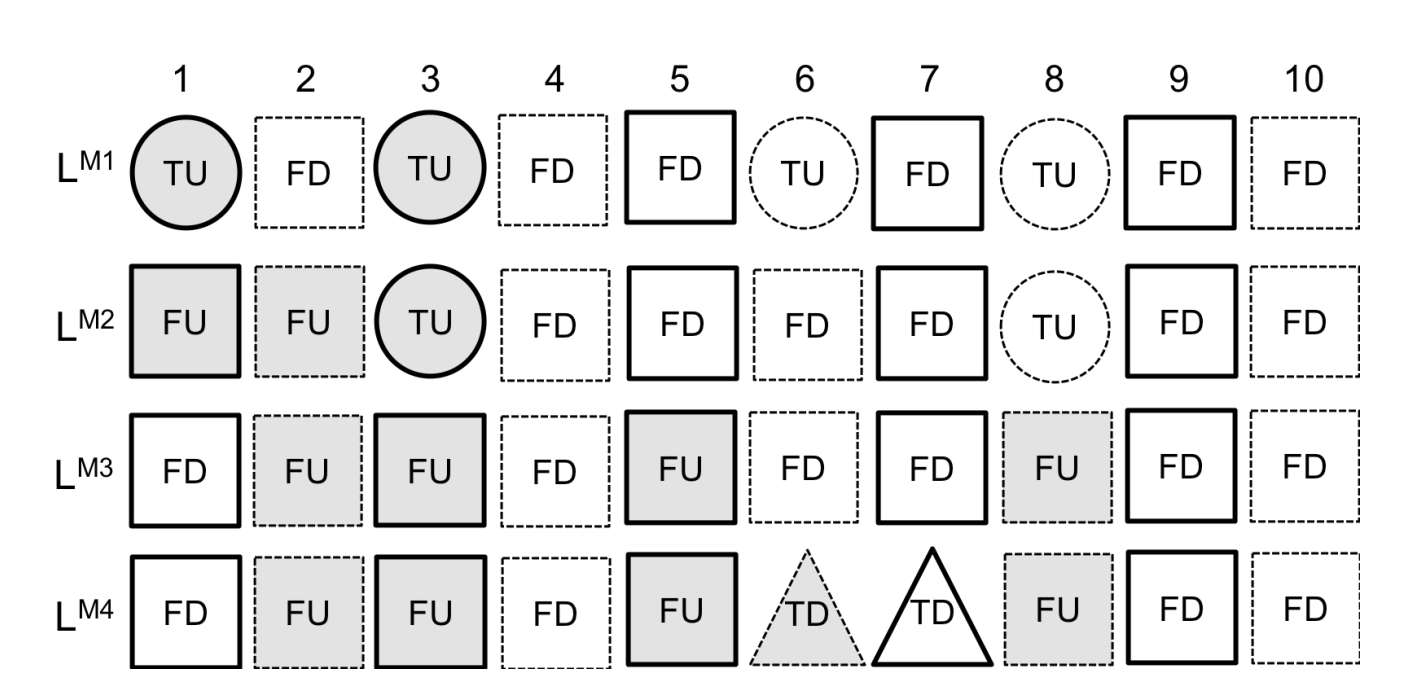
Uplift-based evaluation and optimization of recommenders
Masahiro Sato, Janmajay Singh, Sho Takemori, Takashi Sonoda, Qian Zhang, Tomoko Ohkuma
RecSys '19: Proceedings of the 13th ACM Conference on Recommender Systems
[Abstract] [Paper]Recommender systems aim to increase user actions such as clicks and purchases. Typical evaluations of recommenders regard the purchase of a recommended item as a success. However, the item may have been purchased even without the recommendation. An uplift is defined as an increase in user actions caused by recommendations. Situations with and without a recommendation cannot both be observed for a specific user-item pair at a given time instance, making uplift-based evaluation and optimization challenging. This paper proposes new evaluation metrics and optimization methods for the uplift in a recommender system. We apply a causal inference framework to estimate the average uplift for the offline evaluation of recommenders. Our evaluation protocol leverages both purchase and recommendation logs under a currently deployed recommender system, to simulate the cases both with and without recommendations. This enables the offline evaluation of the uplift for newly generated recommendation lists. For optimization, we need to define positive and negative samples that are specific to an uplift-based approach. For this purpose, we deduce four classes of items by observing purchase and recommendation logs. We derive the relative priorities among these four classes in terms of the uplift and use them to construct both pointwise and pairwise sampling methods for uplift optimization. Through dedicated experiments with three public datasets, we demonstrate the effectiveness of our optimization methods in improving the uplift.